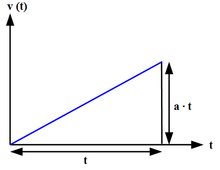 |
| https://goo.gl/dWS2mq |
Summary:
Acceleration is a vector quantity that measures the rate of change in the velocity of an object over time. Acceleration is measured on an acceleration graph where velocity is on the y-axis and time is on the x-axis. The steeper the line is, the bigger the change in velocity is over a short amount of time. If the line is completely horizontal, that means that the object isn't accelerating and thus remains a constant speed. If the line is horizontal and at the x-axis, the object is at rest, meaning that it isn't moving. The formula to find acceleration is the change in velocity divided by the change in time. The unit for the quotient then becomes length/time^2.
SP3 - Planning Investigations:
This week I investigated on how acceleration works. To do this, I worked with two other people and gathered tracks, a book, a yardstick and a toy car. The first step was to assemble a track and a yardstick together. Then, we stacked books under one end so that end was inclined. The next step was to put the car on the ramp and let go of it. One person was to call out the intervals of time since the release of the car and the other two people were to mark where the car was in those intervals of time. We had to repeat this 2 more times and find the average position in each interval of time from those 3 trials. After repeating the trials 3 times, our group was supposed to stack another book with the intent of making the ramp more steeper thus increasing the acceleration of the toy car. From this experiment, I further understood how to find the acceleration of an object.
No comments:
Post a Comment